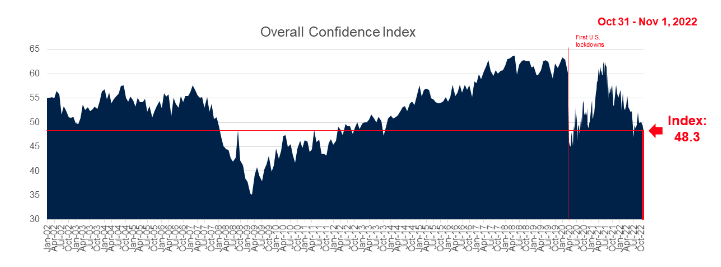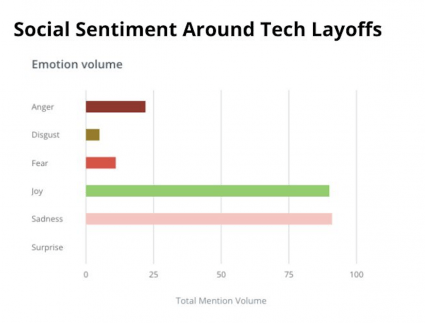In the middle of the busiest shopping season of the year, consumers are getting hit from all sides: they want to embrace the holiday spirit, but the news is full of worrying headlines about the economy, politics, and more.
As a result, consumer sentiment is once again falling as we head into the peak commerce period of Black Friday and Cyber Week.
So what’s a brand to do?
One of the most powerful levers marketers have in the “building customer connection during troubled times” toolbox is brand messaging. The key is to lead with empathy and meet customers where they are emotionally by staying agile and responsive.
That’s how to not just ensure strong performance through the end of the holiday season, but lay the groundwork for long-term loyalty.
What’s affecting consumer sentiment going into the holiday season?
It’s a triple play of words nobody wants to hear and they are all interconnected: inflation, recession, layoffs. The timing of all of this is particularly galling to retailers and ecommerce brands hoping for a big finish to Q4. But it’s not completely black and white.
Here’s a quick rundown on the state of affairs:
Inflation: Let’s start with the good news. Economists from Goldman Sachs announced that they expect a significant decline in U.S. inflation next year. But the long-term prognosis is mixed; while the pace of year-over-year price increases has slowed in part due to the Fed’s actions, credit card rates are higher than ever due to the Fed’s aggressive rate hikes. With the biggest shopping days of the year ahead, consumers will continue to feel the burden of tight budgets.
Recession: 91% of U.S. CEOs think we will be in a recession in the next year, according to a recent KPMG survey. The continuing overall strength of the job market is the main point of contention in the continuing debate over whether we are currently in or will be in a recession in the near future. Which brings us to…
Layoffs: In the same KPMG survey, CEOs say they are preparing for a downturn by reducing headcount. But the big headlines around layoffs have largely stayed in the tech sector, with special attention being paid to the rounds of layoffs at Amazon, Meta, and Twitter. But it’s worth noting that the layoffs at both Amazon and Meta (we’ll leave Twitter’s challenges for another day) are likely correlated with massive hiring during the covid-caused digital boom and may have more to do with “right-sizing” to match a slower pace of consumer reliance on digital channels than the current state of the economy.
It’s not all bad news! In fact, there is a lot more grey area across all three than is apparent at first glance. But the overall effect on consumers has been demoralizing.
The Overall Confidence Index is currently five points below the pandemic average and 11.8 points below where it was in early March 2020. That’s 4.5 points lower than the 20-year historical average.

Source: Ipsos
While the unemployment rate is still low, the tech layoffs in the news have some people worried about their job security, which may affect how they spend this holiday season.
An analysis of Brandwatch data about social consumer sentiment around those tech layoffs tells us that sadness is ruling the emotional tone of conversations on social around the current round of layoffs, although there is also a significant amount of joy that is likely attributable to both community support for those laid off and excitement about possible comeuppance to controversial tech giants and their leaders.

Source: Falcon.IO / Brandwatch
It’s important to remember that changes and disruption are constant, but they also open the door to significant opportunities. When people are anxious or sad, your brand should be ready to respond with help and support. And that starts with messaging with empathy.
How do you build empathy into your brand messaging?
Your messaging doesn’t have to completely ignore what’s happening in the world. In fact, it shouldn’t. Sometimes that means directly addressing the situation if it’s relevant enough to your brand. But it should always mean adapting your messaging and creative to respond to the effect on your audience, whether or not it makes sense to respond head-on.
If your customers are feeling the effects of something happening in the wider world, your brand should be positioned to offer support, comfort, information, or even distraction—whatever makes the most sense. Connecting with your customers during tough times builds trust, which drives long-term loyalty and increases customer lifetime value.
There are a number of ways that you can make sure that you are effectively communicating with your customers.
Monitor major trends that could affect consumer sentiment: Don’t bury your head in the sand because your holiday assets were approved three months ago. You need to pay attention to even subtle shifts in mood when major economic turmoil is possible. Look at past data to understand how something like a recession might affect your customers and how they spend money while keeping pace with current macroeconomic and consumer data that power decisions about potential adjustments to your brand positioning.
Audit your creative and messaging: Take a look at your current creative and associated messaging with an eye toward how the current moment is impacting your customers’ state of mind and purchase behavior. What they want and need may have changed; how they will react to a specific message or a particular image might look different in light of big changes or new headlines. We know that consumers are feeling anxious about the economy and have been delaying large purchases for the better part of a year; we also know they desperately want a real holiday and are still planning to spend to make it happen. How does it make sense for your brand to enter that conversation? What will help make your case or push them to the purchase point if they’re on the fence?
Consider less-used direct lines of communication: We all know that the inbox is getting more and more crowded with brands jockeying for attention via email, and that’s only getting worse as the big days get closer. A strong SMS marketing strategy offers a more personal way to communicate with your customers in a more intimate way. That doesn’t mean spamming your entire database; look to your data to identify loyal shoppers, high LTV customer cohorts, abandoned carts, or other signals that indicate a higher likelihood to purchase, and consider reaching out with exclusive offers or opportunities. If your customers are feeling the pinch of inflation and that’s stopping them from hitting the buy button, a special discount can go a long way.
Leverage data to identify your customers’ pain points: We’ve identified some broad areas like job security or higher prices that might be on your customers’ minds. But broad trends can only take you so far. Look to your first-party data to identify specific pain points and consider how you’re leveraging segmentation and your overall media mix to deliver the right message to those groups. That process should continue long after New Year’s Day has come and gone; the outputs from that ongoing analysis should help drive future content and creative ideation as well as media planning.
Critical moments that change the landscape around your business can serve as a good reminder to reevaluate how you are connecting with your customers. If you can identify and prioritize messaging that authentically align with your customers’ needs as well as your business priorities, you can actually unlock major opportunities for growth.
After all, hope and community are some of the main themes of the season; a brand message that successfully delivers some comfort and joy will go a long way.
Download our full guide to The Silver Lining: How a Recession Unlocks Low-Cost High-Growth Opportunities to make sure you’re fully prepared for potential economic uncertainty.







Responses